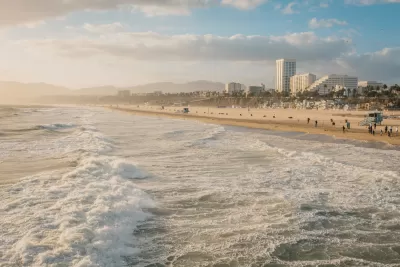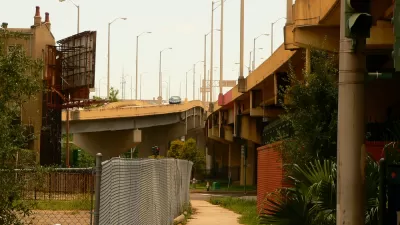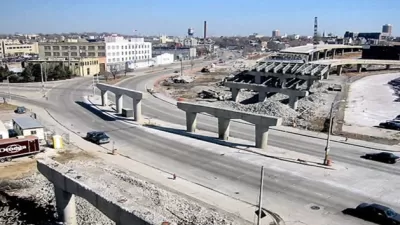A new program seeks to make restitution for the damage inflicted on Black communities by highway construction and urban renewal.

In yet another acknowledgement of the harm done to predominantly Black communities by more than a half-century of urban renewal and freeway construction programs, the beachside city of Santa Monica "will offer affordable housing to those forced out by freeway construction and those removed in the late 1950s when the city bulldozed another Black area, Belmar Triangle, to build the Santa Monica Civic Auditorium." As reported by Liam Dillon, the program will give preference on the city's affordable housing wait list to qualifying families, including the children and grandchildren of displaced residents.
"Nationwide, more than 1 million people lost their homes in just the first two decades of interstate construction alone. Early on, highway planners targeted many Black neighborhoods for destruction, and displaced families often received little compensation." But while the program is an important step, city leaders acknowledge it can't make up for the loss of homes, livelihoods, and generational wealth caused by displacement.
Elsewhere in the country, the city of Evanston, Illinois has created a reparations program for Black residents, and Portland, Oregon offers priority in the city's affordable housing programs to families who experienced displacement in that city, while a proposed bill in the California state legislature would ban freeway expansion in historically underserved communities.
FULL STORY: Santa Monica’s message to people evicted long ago for the 10 Freeway: Come home

Study: Maui’s Plan to Convert Vacation Rentals to Long-Term Housing Could Cause Nearly $1 Billion Economic Loss
The plan would reduce visitor accommodation by 25,% resulting in 1,900 jobs lost.

North Texas Transit Leaders Tout Benefits of TOD for Growing Region
At a summit focused on transit-oriented development, policymakers discussed how North Texas’ expanded light rail system can serve as a tool for economic growth.

Why Should We Subsidize Public Transportation?
Many public transit agencies face financial stress due to rising costs, declining fare revenue, and declining subsidies. Transit advocates must provide a strong business case for increasing public transit funding.

How to Make US Trains Faster
Changes to boarding platforms and a switch to electric trains could improve U.S. passenger rail service without the added cost of high-speed rail.

Columbia’s Revitalized ‘Loop’ Is a Hub for Local Entrepreneurs
A focus on small businesses is helping a commercial corridor in Columbia, Missouri thrive.

Invasive Insect Threatens Minnesota’s Ash Forests
The Emerald Ash Borer is a rapidly spreading invasive pest threatening Minnesota’s ash trees, and homeowners are encouraged to plant diverse replacement species, avoid moving ash firewood, and monitor for signs of infestation.
Urban Design for Planners 1: Software Tools
This six-course series explores essential urban design concepts using open source software and equips planners with the tools they need to participate fully in the urban design process.
Planning for Universal Design
Learn the tools for implementing Universal Design in planning regulations.
City of Santa Clarita
Ascent Environmental
Institute for Housing and Urban Development Studies (IHS)
City of Grandview
Harvard GSD Executive Education
Toledo-Lucas County Plan Commissions
Salt Lake City
NYU Wagner Graduate School of Public Service





























